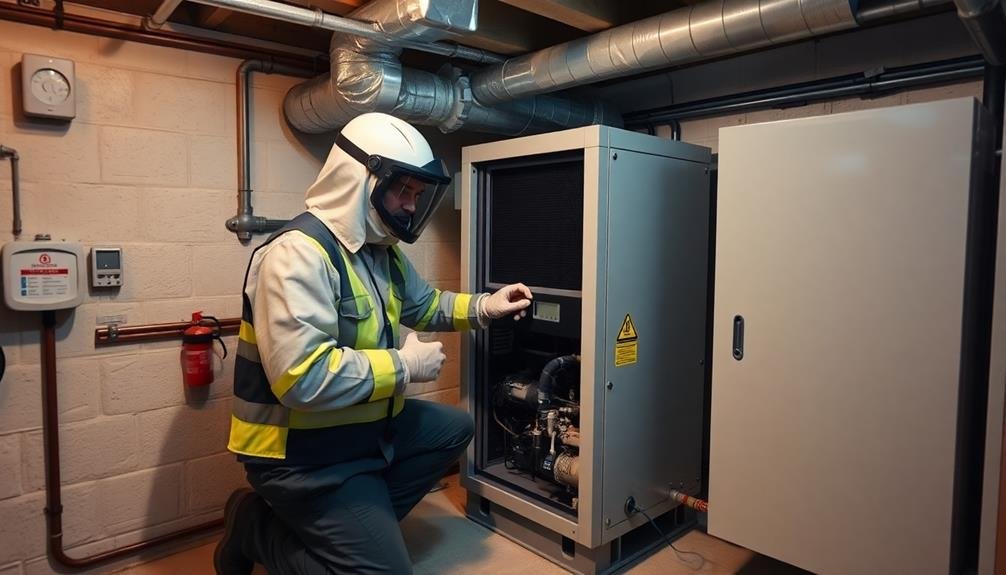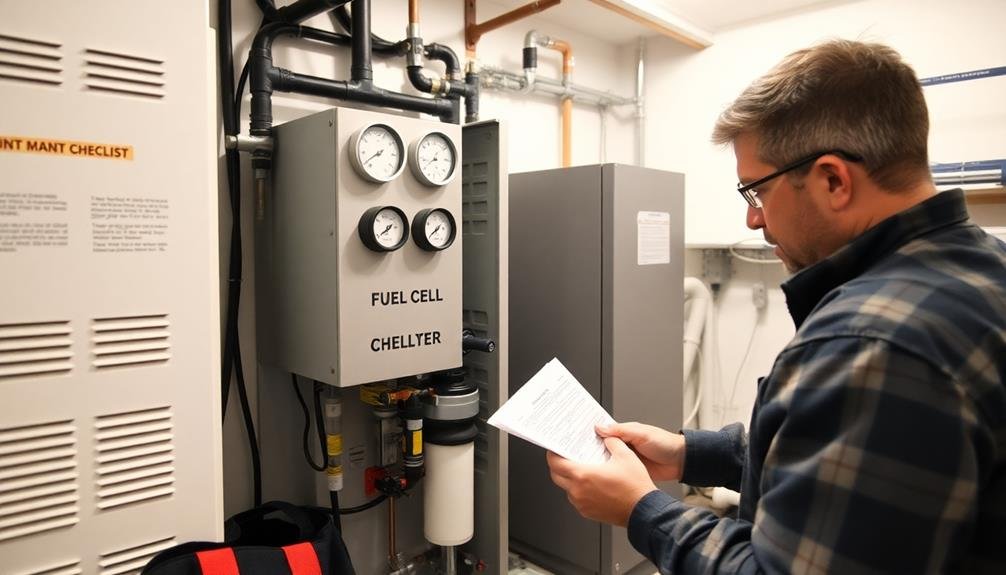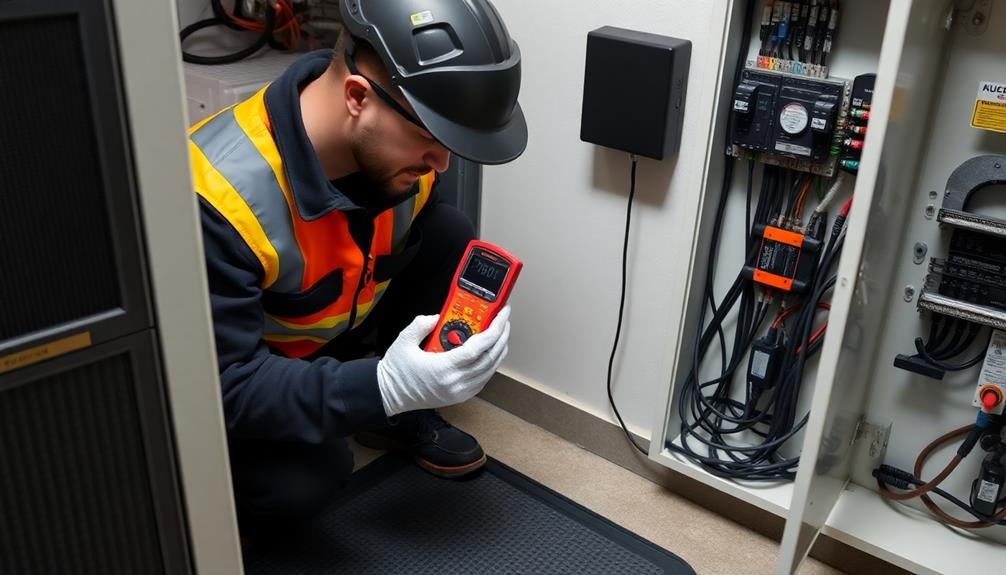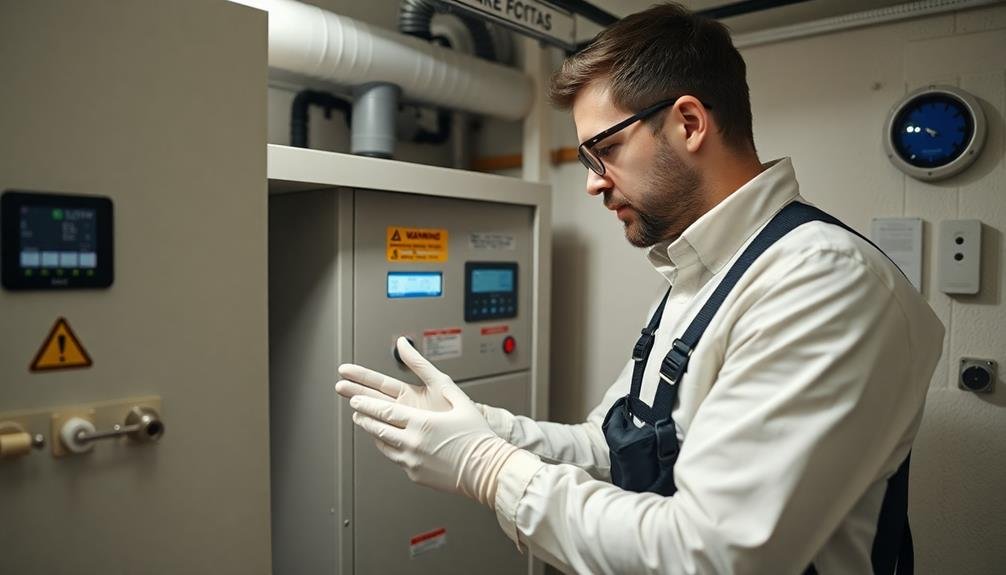Essential safety precautions for home fuel cell systems include proper installation by certified professionals, adequate ventilation, and regular maintenance. You'll need to guarantee compliance with local codes, install gas detectors, and maintain clearance around the unit. Establish emergency shutdown procedures and familiarize yourself with power isolation steps. Implement electrical safety measures like proper grounding and surge protection. Store and handle fuel carefully, following manufacturer guidelines. Stay vigilant for leaks and unusual odors. By prioritizing these safety measures, you'll create a secure environment for your fuel cell system. Discover how these precautions can safeguard your home and family.
Proper Installation and Placement

Guaranteeing proper installation and placement of home fuel cell systems is vital for safe operation. You'll need to work with certified professionals who specialize in fuel cell technology to install your system correctly. They'll guarantee compliance with local building codes and safety regulations.
Your fuel cell system should be installed in a well-ventilated area, preferably outdoors or in a dedicated utility room. This placement helps prevent the accumulation of potentially harmful gases. Make certain there's adequate clearance around the unit for maintenance and airflow.
You'll need to take into account the system's proximity to your home's electrical panel and natural gas supply. The installation should include proper electrical grounding and gas line connections. It's imperative to install carbon monoxide and hydrogen detectors near the fuel cell system to alert you of any leaks.
Don't forget about weather protection. If installed outdoors, your fuel cell system needs shielding from rain, snow, and extreme temperatures. For indoor installations, guarantee proper exhaust venting to the outside.
Lastly, keep the area around your fuel cell system clear of flammable materials and store any fuel safely away from the unit.
Ventilation and Air Quality Control
Proper installation sets the stage for safe operation, but ongoing ventilation and air quality control are equally important for home fuel cell systems.
You'll need to guarantee adequate airflow around your fuel cell to prevent the buildup of potentially harmful gases. Install carbon monoxide detectors near the system and in sleeping areas to alert you of any leaks.
Regularly check and maintain your ventilation system, including exhaust fans and air intakes. Keep the area around your fuel cell free from obstructions that could impede airflow.
If you notice unusual odors or experience headaches, nausea, or dizziness, immediately shut off the system and evacuate your home.
It's vital to monitor humidity levels, as excessive moisture can affect fuel cell performance and promote mold growth. Use dehumidifiers if necessary to maintain ideal conditions.
Additionally, install air filters to remove particulates that could damage the fuel cell or reduce its efficiency.
Don't forget to schedule regular professional inspections of your ventilation system and fuel cell. These checks can identify potential issues before they become serious safety hazards, making sure your home remains a safe and comfortable environment.
Regular Maintenance and Inspections

Vigilance is key when it comes to regular maintenance and inspections of your home fuel cell system. You should establish a routine maintenance schedule and stick to it religiously. This includes checking for any signs of wear, tear, or damage to the system's components.
Don't ignore even minor issues, as they can quickly escalate into major problems if left unaddressed.
It's essential to keep detailed records of all maintenance activities and inspections. This documentation will help you track the system's performance over time and identify any recurring issues. You should also familiarize yourself with the manufacturer's guidelines for maintenance and follow them strictly.
Here are three important aspects of regular maintenance and inspections:
- Inspect fuel cell stack: Check for any signs of corrosion, leaks, or degradation.
- Monitor system performance: Regularly review efficiency metrics and power output.
- Test safety systems: Verify all alarms, shutoffs, and emergency systems are functioning correctly.
Emergency Shutdown Procedures
In an emergency, you'll need to know how to quickly shut down your home fuel cell system.
Familiarize yourself with the step-by-step process for power isolation to prevent potential hazards.
After the shutdown, it's essential to perform safety checks to guarantee all components are secure and no residual risks remain.
Quick Shutdown Steps
During an emergency, knowing how to quickly shut down your home fuel cell system can prevent potential disasters.
You'll need to act swiftly and decisively to guarantee your safety and that of your property. Familiarize yourself with these quick shutdown steps before an emergency occurs.
First, locate the main power switch on your fuel cell system. It's typically a large, red button or lever clearly labeled "Emergency Stop" or "Main Power Off." Press or pull this switch immediately to cut off the system's power supply.
Next, follow these critical steps:
- Close the main fuel supply valve. This valve is usually located near the fuel cell unit or where the fuel line enters your home.
- Activate the automatic fire suppression system if your fuel cell has one. This will help contain any potential fires.
- Evacuate the area immediately and call emergency services. Don't attempt to re-enter until professionals have declared it safe.
Power Isolation Process
While quick shutdown steps are essential in an emergency, understanding the complete power isolation process is equally important for your safety.
Begin by activating the emergency stop button on your fuel cell system's control panel. This immediately cuts off the fuel supply and initiates the system's internal shutdown sequence.
Next, you'll need to disconnect the fuel cell from external power sources. Locate the main electrical disconnect switch, typically near your home's electrical panel, and turn it off. This isolates the fuel cell system from your home's electrical grid.
If your system has a battery backup, you'll need to disconnect it as well. Find the battery isolation switch and turn it to the "off" position.
Now, focus on isolating the fuel supply. Close the main gas valve if your system uses natural gas or propane. For hydrogen-based systems, shut off the hydrogen supply valve.
Don't forget to ventilate the area by opening windows and doors to disperse any potentially leaked gases.
Lastly, contact your fuel cell system's manufacturer or a certified technician for a thorough inspection before attempting to restart the system. They'll verify all components are functioning correctly and it's safe to resume operation.
Post-Shutdown Safety Checks
Safety doesn't end with shutting down your home fuel cell system. After an emergency shutdown, it's vital to perform post-shutdown safety checks to guarantee your home and family remain protected.
These checks help identify any potential hazards that may have arisen during the shutdown process.
Begin by visually inspecting the fuel cell unit and surrounding area. Look for signs of damage, leaks, or unusual odors. Don't touch any components until you're certain it's safe to do so.
Next, verify that all power sources are completely disconnected and the system is fully depressurized.
Here are three essential post-shutdown safety checks:
- Test the air quality in the room where the fuel cell is located using a gas detector.
- Check all electrical connections for signs of overheating or damage.
- Inspect fuel supply lines and connections for any leaks or corrosion.
If you notice any issues during these checks, don't attempt to restart the system. Instead, contact a qualified technician immediately.
They'll assess the situation and make necessary repairs before giving you the all-clear to resume operation.
Electrical Safety Measures

Three vital electrical safety measures are essential when operating a home fuel cell system.
First, guarantee proper grounding of all electrical components. You'll need to connect the fuel cell system to a dedicated ground rod or your home's existing grounding system. This prevents electrical shock and protects against power surges.
Second, install ground fault circuit interrupters (GFCIs) on all outlets connected to the fuel cell system. GFCIs quickly cut off power if they detect an imbalance in the electrical current, reducing the risk of electrocution.
Third, use appropriate insulation and shielding for all wiring. You must use cables rated for the voltage and current of your fuel cell system, and confirm they're properly protected from physical damage and environmental factors.
Additionally, regularly inspect all electrical connections for signs of wear, corrosion, or loose fittings. Replace any damaged components immediately.
It's essential to keep the area around your fuel cell system dry and free from conductive materials. Never attempt to service the electrical components yourself; always consult a qualified technician for repairs or maintenance.
Fuel Storage and Handling
Proper fuel storage and handling are just as important as electrical safety for home fuel cell systems. You'll need to take precautions to guarantee the safe storage and use of your fuel, whether it's hydrogen, natural gas, or another type. Always follow manufacturer guidelines and local regulations for fuel storage.
Store your fuel in a well-ventilated area away from heat sources and electrical equipment. If you're using hydrogen, make sure your storage containers are designed specifically for this highly flammable gas. For natural gas systems, verify your home's gas lines are regularly inspected for leaks.
When handling fuel, take these essential precautions:
- Wear appropriate personal protective equipment (PPE), including gloves and safety glasses
- Use proper tools and equipment designed for fuel handling
- Never smoke or use open flames near fuel storage or handling areas
Be alert for any signs of leaks, such as unusual odors or hissing sounds. If you suspect a leak, immediately shut off the fuel supply, ventilate the area, and contact a professional for assistance. Don't attempt to repair leaks yourself unless you're trained to do so.
Regular maintenance of your fuel storage system is vital. Schedule professional inspections and replace any worn or damaged components promptly to prevent potential hazards.
Frequently Asked Questions
How Do Fuel Cells Compare to Traditional Power Sources in Terms of Cost?
You'll find fuel cells are often more expensive upfront than traditional power sources. However, they can be cost-effective long-term due to their efficiency and lower operating costs. Consider your specific energy needs when comparing costs.
Can Home Fuel Cell Systems Be Integrated With Existing Solar Panel Setups?
Yes, you can integrate home fuel cell systems with existing solar panels. They're complementary technologies that can work together. You'll need a compatible inverter and control system to manage power flow between the fuel cells, solar panels, and your home.
What Is the Average Lifespan of a Residential Fuel Cell System?
You'll typically find that residential fuel cell systems last 10-15 years. However, you can extend their lifespan with proper maintenance. Some newer models may even operate efficiently for up to 20 years with regular care and upkeep.
Are There Government Incentives Available for Installing Home Fuel Cell Systems?
Yes, you'll often find government incentives for home fuel cell systems. Check your local and federal programs for tax credits, rebates, and grants. They're designed to encourage clean energy adoption, but availability varies by location and time.
How Noisy Are Fuel Cell Systems During Operation?
You'll be pleased to know that fuel cell systems are typically very quiet during operation. They don't have many moving parts, so they're often compared to a refrigerator with respect to noise level. You'll hardly notice them running.
In Summary
You've learned essential safety measures for home fuel cell systems. Remember, proper installation, ventilation, and maintenance are vital. Don't neglect regular inspections and be prepared with emergency procedures. Always prioritize electrical safety and handle fuel carefully. By following these precautions, you'll minimize risks and enjoy the benefits of your fuel cell system. Stay vigilant and keep safety at the forefront to guarantee a smooth, efficient, and secure operation in your home.





Leave a Reply